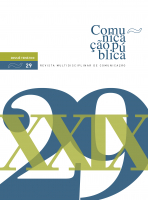Esteves, João Pissarra (2019). Comunicação política e democracia. Coimbra: Imprensa da Universidade de Coimbra. 387 pp. ISBN: 978-989-26-1735-0
DOI:
https://doi.org/10.4000/cp.11246Abstract
Several years before Gustave Le Bon published Psychologie des Foules (1895) and Gabriel Tarde (1901) distinguished between crowd and public in his studies, the Portuguese politician and historian Joaquim de Oliveira Martins had already published a curious article in which he defined the public as “powerful, invincible as fate; hysterical as a nervous woman; naive as a child” (Oliveira Martins, 1924 [1886], p. 88) and raised concerns about the relationship between citizens and the media: “How many times have we annoyed and bored you by trying to make you think, placing before your eyes the crucial problems of the nation’s economic life, the problems of your life? You want excited nerves: sensational news and scandals” (Ibid., p. 90). He also describes citizens’ cynicism toward politics and their consequent disengagement: “You always grumble about politicians, and you make them in your own image and likeness. If they do not deceive you, if they do not flatter your depravity or your whims, you stone them. [...] You dislike the work of thinking and reflecting; you entrust this task to your representatives, whom you choose at random, with closed eyes” (Ibid., p. 91). Although the “great anonymous” (Ibid., p. 89) is described more in the irritable style of Wilhelm Reich’s “Nobody” (1972) than in Walter Lippmann’s notion of “public opinion” (1922), this brief text by Oliveira Martins managed to raise the longstanding problem that has always concerned publicists, scholars, historians, philosophers, sociologists, and current social science researchers: understanding the extensive triad of power–media–public, which so clearly represents the pillars of political communication.
Downloads
References
Bennett, L. W. (1983). News: The politics of illusion. Nova Iorque: Longman.
Blumenthal, S.. (1980). The permanent campaign: Inside the world os elite political operatives. Boston: Beacon Press.
Dinan, W., & Miller, D.. (2007). Thinker, faker, spinner, spy: Corporate PR and the assault on democracy. Londres: Pluto Press.
Eldridge, J. (Org.). (1993). Getting the message: news, truth and power. Londres: Routledge.
Esteves, J. P.. (2003). Espaço público e democracia: comunicação, processos de sentido e identidades sociais. Lisboa: Editora Colibri.
Esteves, J. P. (2004). O espaço público e os media – sobre a comunicação entre normatividade e facticidade. Lisboa: Edições Colibri.
Esteves, J. P. (2007). A ética da comunicação e os media modernos: legitimidade e poder nas sociedades complexas. Lisboa: Fundação Calouste Gulbenkian.
Esteves, J. P. (Org.). (2007). Comunicação e identidades sociais: diferença e reconhecimento em sociedades complexas e culturas pluraristas. Lisboa: Livros Horizonte.
Esteves, J. P. (Org.). (2009). Comunicação e sociedade: os efeitos sociais dos meio de comunicação de massa. Lisboa: Livros Horizonte.
Esteves, J. P. (2011). Sociologia da comunicação. Lisboa: Fundação Calouste Gulbenkian.
GUMG. (1995 [1980]). Glasgow University Media Group, a Reader: News content, language and visuals. Londres/Nova Iorque: Routledge.
Habermas, J. (2012). A transformação estrutural da esfera pública: investigações sobre uma categoria da sociedade burguesa. Lisboa: Fundação Calouste Gulbenkian.
Le Bon, G. (1895). Psychologie des foules. Paris: Édition Félix Alcan.
Lippmann, W. (1922). Public opinion. Nova Iorque: Harcourt, Brace and Company.
Martins, J. P. O. (1924 [1886]). "Público". In António Sérgio (Ed.), Oliveira Martins: dispersos. Lisboa: Biblioteca Nacional.
Mesquita, M. (Org.). (1995). Comunicação e política. Lisboa: Cosmos.
Meyer, T. (2002). Media democracy: How the media colonize politics. Cambridge: Polity.
Miller, D., & Dinan, W. (2008). A century of spin: How Public Relations became the cutting edge of corporate power. Londres: Pluto.
Nobre-Correia, J. M. (1996). A cidade dos media. Porto: Campo das Letras.
Norris, P. (2000). A virtuous circle: Political communication in postindustrial societies. Cambridge: Cambridge University Press.
Reich, W. (1972). Escuta, Zé Ninguém. Lisboa: Publicações D. Quixote.
Rodrigues, A. D. (1985). O campo dos media. Lisboa: Vega.
Santos, J. de A.. (2012). Media e poder: o poder mediático e a erosão da democracia representativa. Lisboa: Vega.
Scammell, M. (1995). Designer politics – How elections are won. Londres: MacMillan Press.
Sousa, H (Org.). (2006). Comunicação, economia e poder. Porto: Porto Editora.
Street, J. (2011). Mass media, politics & democracy. Hampshire: Palgrave Macmillan.
DOI : 10.1007/978-1-137-01555-6
Tarde, G. (1901). L'opinion et la foule. Paris: Felix Alcan.
Traquina, N. (1993). Jornalismo: questões, teorias e "estórias". Lisboa: Vega.
Downloads
Published
Issue
Section
License
Copyright (c) 2020 Direitos do Autor (c) 2020

This work is licensed under a Creative Commons Attribution-NonCommercial 4.0 International License.
Os conteúdos da Comunicação Pública estão licenciados com uma licença Creative Commons - Atribuição-NãoComercial 4.0 Internacional.


